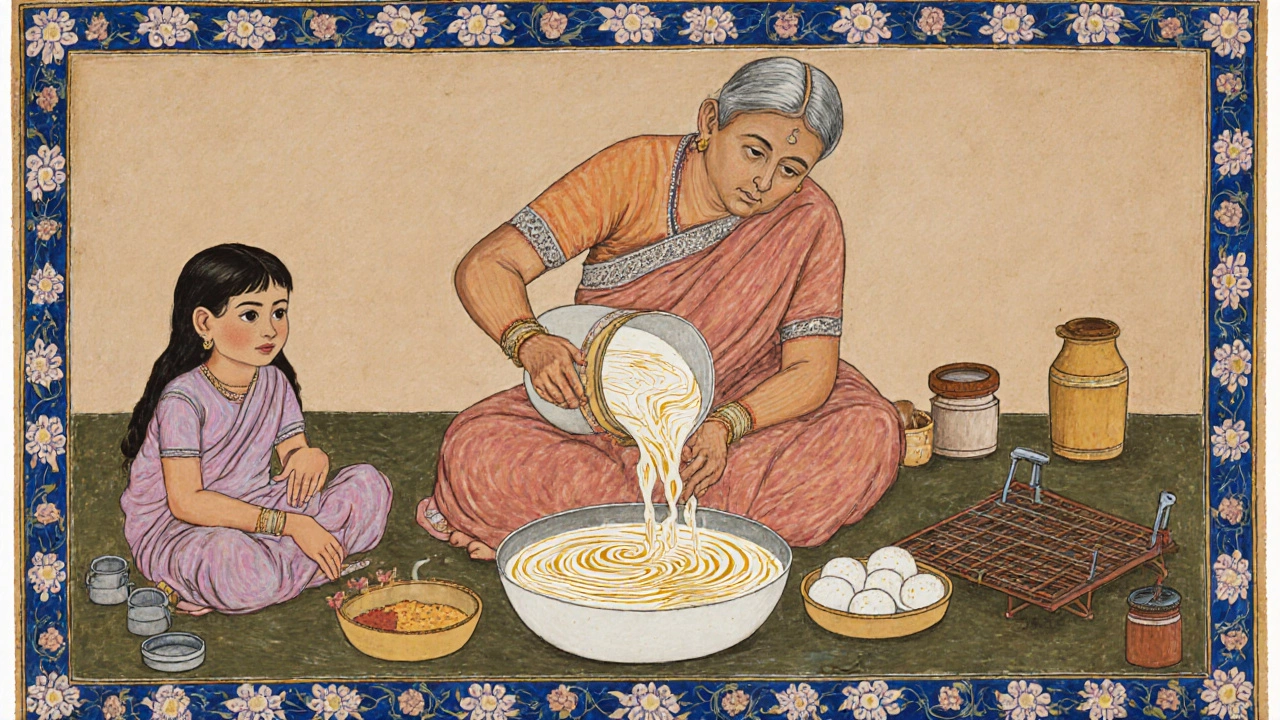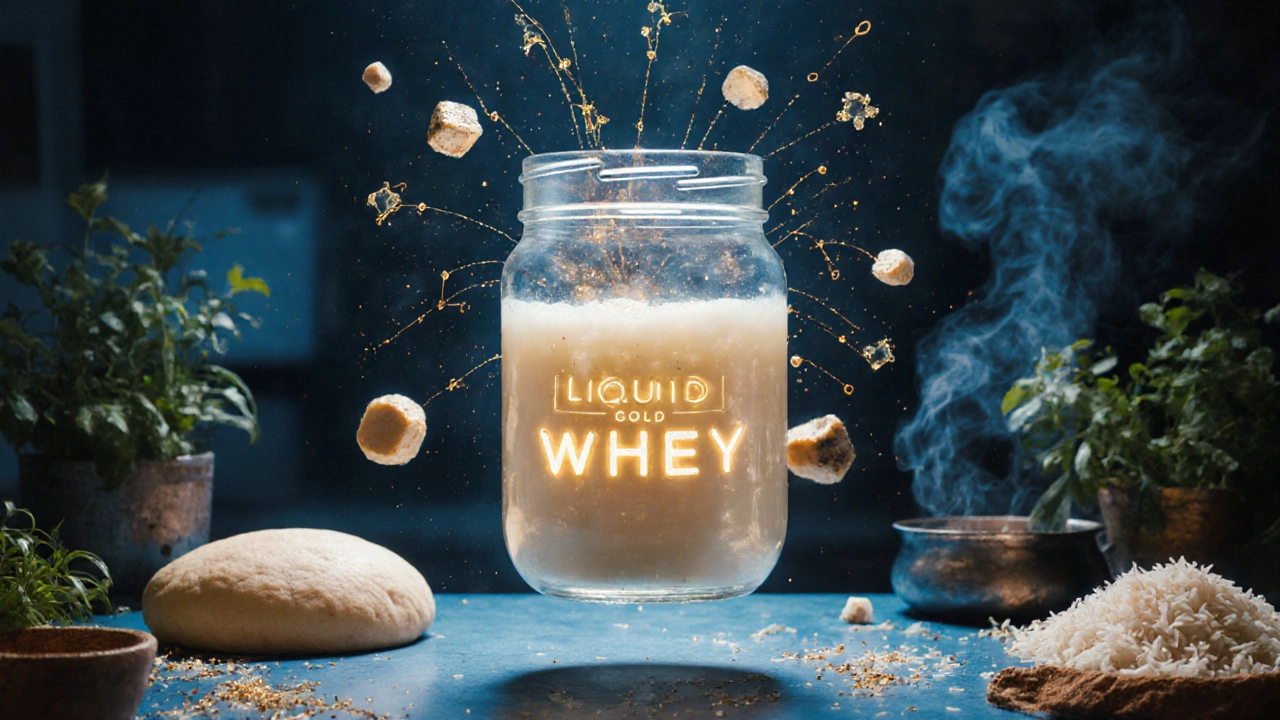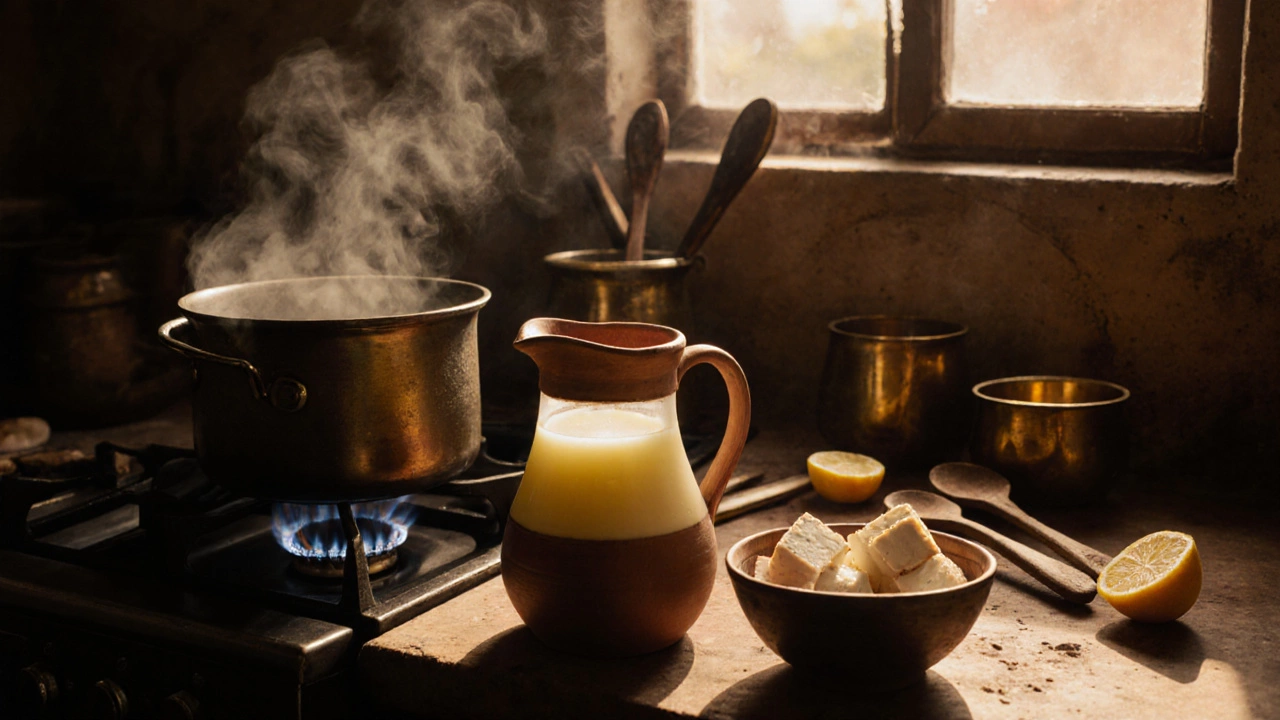30 Oct 2025
- 0 Comments
Whey Value Calculator
Calculate Your Whey Value
Determine how much protein you're wasting when you discard paneer whey, and how you can benefit from using it.
0g Protein
Total protein value in your whey
$0.00
Cost Savings
$0.00
If you bought protein powder
When you make paneer at home, you end up with a big pitcher of leftover liquid. It’s not water. It’s not milk. It’s whey-the clear, slightly yellowish stuff that separates when you heat milk and add lemon juice or vinegar. You might think, "This looks like waste." But here’s the truth: whey is packed with protein, vitamins, and minerals. And yes, you can drink it.
What exactly is whey from paneer?
Paneer is made by curdling whole milk with an acid-usually lemon juice, vinegar, or yogurt. When you do this, the milk proteins (casein) clump together into solid curds. What’s left behind is whey. It’s about 90% water, but the other 10% is where the magic happens: lactose, minerals like calcium and potassium, and small amounts of milk proteins that didn’t clump up-mostly whey proteins like beta-lactoglobulin and alpha-lactalbumin.
Unlike commercial cheese whey, which is often processed and pasteurized, paneer whey is fresh, unfiltered, and full of live enzymes. It’s the same liquid used in many traditional Indian dishes, like making idli batter or fermenting dosa batter. But most people pour it down the drain. That’s a mistake.
Is it safe to drink paneer whey?
Yes-if you made it cleanly. If you used fresh milk, clean utensils, and didn’t let it sit out for more than a few hours, drinking it is perfectly safe. It’s not raw milk, because you’ve already heated it to boiling. The acid you added (lemon or vinegar) further lowers the pH, making it hostile to harmful bacteria.
Some people worry about lactose. Paneer whey still contains lactose-about 5-7 grams per cup-so if you’re severely lactose intolerant, you might feel bloated. But for most people, even those with mild sensitivity, it’s fine. The fermentation process in traditional cooking actually breaks down some lactose, and many find whey easier to digest than milk.
What does it taste like?
Don’t expect it to taste like a smoothie. Paneer whey is mild, slightly tangy, and watery-like diluted buttermilk with a faint dairy sweetness. Some say it tastes like the ghost of milk. It’s not unpleasant, but it’s not exciting on its own. That’s why most people don’t drink it straight. But here’s the thing: you don’t have to.
How to make it taste good (and useful)
Instead of chugging it, use it like a secret ingredient. Here’s how real cooks use it:
- Replace water in doughs: Use whey instead of water when making roti, paratha, or naan. It adds protein, softness, and a subtle tang. Your bread stays fresh longer.
- Ferment batter: For idli, dosa, or uttapam batter, swap water for whey. The natural lactic acid helps fermentation, making the batter rise faster and taste richer.
- Smoothies: Blend it with banana, mango, a pinch of cardamom, and a spoon of honey. It’s like a protein-packed Indian milkshake.
- Cook rice or dal: Use whey instead of water when boiling rice or cooking lentils. It adds nutrients and a light creaminess without fat.
- Vegetable brine: Use it to pickle carrots, radishes, or green chilies. It’s a natural, probiotic-rich alternative to vinegar brine.
- Plant fertilizer: If you have a garden, dilute whey 1:5 with water and water your plants. It’s rich in nitrogen and calcium.

How long does it last?
Store paneer whey in a sealed glass jar in the fridge. It will keep for 3-4 days. After that, it starts to ferment more actively-becoming tangier, slightly fizzy, and eventually sour. That’s not bad. In fact, fermented whey is used in some cultures as a digestive tonic. If it smells like yogurt or sour milk and doesn’t have mold, it’s still safe to use in cooking.
But if it smells rotten, looks slimy, or has green or black spots, throw it out. That’s spoilage, not fermentation.
What’s the nutrition in paneer whey?
One cup (240 ml) of fresh paneer whey contains roughly:
- 12-15 grams of protein (mostly whey proteins)
- 10-12 grams of carbohydrates (mostly lactose)
- 100-120 mg of calcium
- 400-500 mg of potassium
- 15-20 IU of vitamin D
- Small amounts of B vitamins and magnesium
That’s more protein than a glass of cow’s milk-and you didn’t even buy it. You made it from milk you already had. That’s efficiency.
Why do people think you can’t drink it?
Mostly because of confusion with commercial cheese whey. In industrial cheese-making, whey is often a byproduct of rennet-based coagulation, and it’s treated as waste unless sold to protein powder companies. That’s not your situation.
Also, many people don’t know how to use it. They see a liquid and assume it’s useless. But in rural India, grandmothers have always saved whey. They use it for everything-from feeding livestock to making fermented drinks like kanji. It’s not a waste product. It’s a resource.

What about protein powder? Should I just buy it instead?
You could. But here’s the difference: commercial whey protein is isolated, concentrated, and stripped of everything except the protein. It’s a supplement. Paneer whey is whole food. It comes with natural enzymes, minerals, and lactose that help your body absorb the protein better. You’re not just getting protein-you’re getting the full package your body recognizes.
Plus, it’s free. You already paid for the milk. You already did the work. Why throw away the best part?
Real-life example: A Sydney kitchen
Last week, a friend in Marrickville made paneer for a curry. She saved the whey, poured it into a jar, and forgot about it. Three days later, she noticed it had thickened slightly and smelled like yogurt. Instead of dumping it, she used it to ferment her idli batter. The next morning, the batter rose beautifully-faster than usual-and the idlis were softer, fluffier, and had a subtle tang she couldn’t explain. She didn’t know it was the whey. But it was.
That’s the power of using what you already have.
Bottom line: Drink it, use it, don’t waste it
You don’t need to chug a glass of paneer whey every morning. But you should never pour it down the drain. It’s not trash. It’s a nutrient-rich, low-cost, zero-waste ingredient that’s been used for centuries. Whether you blend it into a smoothie, use it to cook rice, or ferment your next batch of dosa batter-you’re not just being smart. You’re honoring a tradition.
Next time you make paneer, save the whey. Give it a name. Call it "liquid gold." Then use it. Your body, your wallet, and the planet will thank you.
Can I drink whey from paneer straight without mixing it?
Yes, you can drink it straight if it’s fresh and stored properly. It’s safe, but the taste is mild and watery-some find it bland. Most people prefer to mix it into smoothies, soups, or use it in cooking where the flavor blends in naturally.
Does drinking paneer whey help with digestion?
Yes, because it contains natural lactic acid and live enzymes from the curdling process. These help balance gut bacteria and improve digestion. In traditional Indian households, whey is often used as a light digestive drink after heavy meals.
Is paneer whey high in lactose?
It contains about 5-7 grams of lactose per cup-less than a glass of milk, but still present. If you’re mildly lactose intolerant, you may tolerate it fine, especially if used in cooking or fermented. Those with severe intolerance should avoid it or use lactase drops.
Can I freeze paneer whey for later use?
Yes. Freeze it in ice cube trays or small containers. Frozen whey lasts up to 3 months. Thaw it in the fridge before using. It works perfectly in soups, stews, and baked goods-just don’t expect it to be smooth after thawing.
What’s the difference between paneer whey and Greek yogurt whey?
Paneer whey comes from acid-coagulated milk (lemon/vinegar), while Greek yogurt whey comes from strained yogurt, which was fermented first. Paneer whey is more watery and has a sharper tang. Greek yogurt whey is thicker and milder. Both are nutritious, but paneer whey is better for fermenting doughs, while Greek whey works better in smoothies.
Can I use whey from store-bought paneer?
Usually not. Store-bought paneer is often pressed and packaged with little to no whey left. Even if there’s liquid, it may have preservatives or be pasteurized to the point where enzymes are dead. Homemade paneer whey is far more nutritious and useful.
